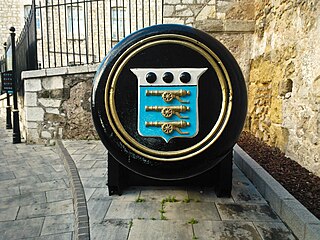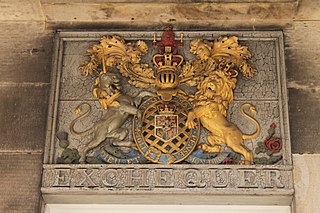Related Research Articles

The Board of Ordnance was a British government body. Established in the Tudor period, it had its headquarters in the Tower of London. Its primary responsibilities were 'to act as custodian of the lands, depots and forts required for the defence of the realm and its overseas possessions, and as the supplier of munitions and equipment to both the Army and the Navy'. The Board also maintained and directed the Artillery and Engineer corps, which it founded in the 18th century. By the 19th century, the Board of Ordnance was second in size only to HM Treasury among government departments. The Board lasted until 1855, at which point it was disbanded.

The post of Controller of the Navy was originally created in 1859 when the Surveyor of the Navy's title changed to Controller of the Navy. In 1869 the controller's office was abolished and its duties were assumed by that of the Third Naval Lord whose title then changed to Third Naval Lord and Controller of the Navy. In 1904 the title was changed again to Third Sea Lord and Controller of the Navy. In 1965 the office of the Third Sea Lord was abolished. The post-holder is responsible for procurement and matériel in the British Royal Navy.

The Navy Board was the commission responsible for the day-to-day civil administration of the Royal Navy between 1546 and 1832. The board was headquartered within the Navy Office.

The National Audit Office (NAO) is an independent Parliamentary body in the United Kingdom which is responsible for auditing central government departments, government agencies and non-departmental public bodies. The NAO also carries out value for money (VFM) audits into the administration of public policy.
A commissariat is a department or organization commanded by a commissary or by a corps of commissaries.
A comptroller is a management-level position responsible for supervising the quality of accounting and financial reporting of an organization. A financial comptroller is a senior-level executive who acts as the head of accounting, and oversees the preparation of financial reports, such as balance sheets and income statements.
A commissary is a government official charged with oversight or an ecclesiastical official who exercises in special circumstances the jurisdiction of a bishop.

The Royal Army Service Corps (RASC) was a corps of the British Army responsible for land, coastal and lake transport, air despatch, barracks administration, the Army Fire Service, staffing headquarters' units, supply of food, water, fuel and domestic materials such as clothing, furniture and stationery and the supply of technical and military equipment. In 1965 its functions were divided between other Corps and the RASC ceased to exist; subsequently, in 1993, they in their turn became the "Forming Corps" of the Royal Logistic Corps.

The Royal Army Veterinary Corps (RAVC), known as the Army Veterinary Corps (AVC) until it gained the royal prefix on 27 November 1918, is an administrative and operational branch of the British Army responsible for the provision, training and care of animals. They are also responsible for explosives and drug search dogs. It is a small corps, forming part of the Army Medical Services.

The Royal Army Ordnance Corps (RAOC) was a corps of the British Army. At its renaming as a Royal Corps in 1918 it was both a supply and repair corps. In the supply area it had responsibility for weapons, armoured vehicles and other military equipment, ammunition and clothing and certain minor functions such as laundry, mobile baths and photography. The RAOC was also responsible for a major element of the repair of Army equipment. In 1942 the latter function was transferred to the Royal Electrical and Mechanical Engineers (REME) and the vehicle storage and spares responsibilities of the Royal Army Service Corps were in turn passed over to the RAOC. The RAOC retained repair responsibilities for ammunition, clothing and certain ranges of general stores. In 1964 the McLeod Reorganisation of Army Logistics resulted in the RAOC absorbing petroleum, rations and accommodation stores functions from the Royal Army Service Corps as well as the Army Fire Service, barrack services, sponsorship of NAAFI (EFI) and the management of staff clerks from the same Corps. On 5 April 1993, the RAOC was one of the corps that amalgamated to form The Royal Logistic Corps (RLC).

The New York State Comptroller is an elected constitutional officer of the U.S. state of New York and head of the New York state government's Department of Audit and Control. Sixty-one individuals have held the office of State Comptroller since statehood. The incumbent is Thomas DiNapoli, a Democrat.

The Commissioners for the Victualling of the Navy, often called the Victualling Commissioners or Victualling Board, was the body responsible under the Navy Board for victualling ships of the British Royal Navy. It oversaw the vast operation of providing naval personnel with enough food, drink and supplies to keep them fighting fit, sometimes for months at a time, in whatever part of the globe they might be stationed. It existed from 1683 until 1832 when its function was first replaced by the Department of the Comptroller of Victualling and Transport Services until 1869 then that office was also abolished and replaced by the Victualling Department.

The Scottish Exchequer had a similar role of auditing and deciding on royal revenues as in England. It was not until 1584 that it also became a court of law, separate from the King's Privy Council. Even then, the judicial and administrative roles never became completely separated into two bodies, as with the English Exchequer. The Auditor of the Exchequer played a pivotal role in this important office of state.

The Transport Board was a British government organisation responsible periodically for the overseas transport of troops and horses, arms and ammunition, naval and military supplies, provisions and other items. It is also referred to as the Board of Transport and the Transport Office.
The Comptroller General of the Exchequer was a position in the Exchequer of HM Treasury between 1834 and 1866. The Comptroller General had responsibility for authorising the issue of public monies from the Treasury to government departments.

The Office of the Comptroller and Auditor General of Bangladesh (C&AG) is the Supreme Audit Institution (SAI) of the country. Like the SAIs in many other countries across the world the institution is established by the Constitution of Bangladesh. This institute is responsible for maintaining accounts of the republic and audits all receipts and expenditure of the Government of Bangladesh, including those of bodies and authorities substantially financed by the government. The reports of the CAG are discussed by the Public Accounts Committee, which is a standing committee in the Parliament of Bangladesh.

During the early 17th century, England's relative naval power deteriorated; in the course of the rest of the 17th century, the office of the Admiralty and Marine Affairs steered the Navy's transition from a semi-amateur Navy Royal fighting in conjunction with private vessels into a fully professional institution, a Royal Navy. Its financial provisions were gradually regularised, it came to rely on dedicated warships only, and it developed a professional officer corps with a defined career structure, superseding an earlier mix of sailors and socially prominent former soldiers.

The Glorious Revolution of 1688 rearranged the political map of Europe, and led to a series of wars with France that lasted well over a century. This was the classic age of sail; while the ships themselves evolved in only minor ways, technique and tactics were honed to a high degree, and the battles of the Napoleonic Wars entailed feats that would have been impossible for the fleets of the 17th century. Because of parliamentary opposition, James II fled the country. The landing of William III and the Glorious Revolution itself was a gigantic effort involving 100 warships and 400 transports carrying 11,000 infantry and 4,000 horses. It was not opposed by the English or Scottish fleets.
The Commissioners of Audit had responsibility from 1785 to 1866 for the auditing of public accounts in the United Kingdom.

The Controller of Treasurer Accounts also called Comptroller of Treasurer Accounts was the civilian officer in the Royal Navy who was a principal member of the Navy Board initially from 1667 to 1679 and then again from 1691 until 1796, he was responsible for inspecting the accounts of the money received by and paid out of the Treasurer of the Navy's department on behalf of the Navy Board. He was based in the Navy Office
References
- 1 2 3 Drinkwater, Lt-Col John (1835). Statements respecting the late Departments of the Comptrollers of the Army. London: William Nicol.
- 1 2 Roper, Michael (1998). The Records of the War Office and Related Departments, 1660-1964. Kew, Surrey: Public Record Office.
- ↑ Sainty, J. C. "Comptrollers of Army Accounts". Institute of Historical Research. Retrieved 10 December 2018.
- ↑ "D'OYLY, Christopher". The History of Parliament. Institute of Historical Research. Retrieved 10 December 2018.